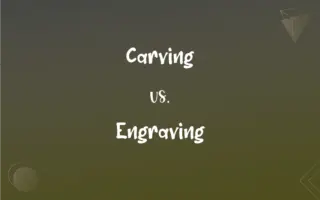Trench vs. Sap: What's the Difference?
By Janet White & Harlon Moss || Updated on May 22, 2024
A trench is a long, narrow excavation in the ground used for military or construction purposes, while a sap is a smaller, often covered trench used in military contexts to approach enemy positions.

Key Differences
A trench is a long, narrow ditch dug into the ground, often associated with military and construction applications. In military contexts, trenches are used as defensive positions, providing soldiers with protection from enemy fire. A sap, on the other hand, is a smaller trench that is typically narrower and more concealed than a standard trench. In military terms, saps are used to approach enemy lines stealthily.
In construction, trenches are excavated for installing utilities like water, sewer, or electrical lines. These trenches are carefully measured and reinforced to ensure safety and stability. While saps are primarily a military concept, they sometimes refer to any small, narrow trench used for specific purposes.
Trenches are significant in both military and civil engineering contexts, serving various practical needs from protection to infrastructure. Saps, however, are specifically tailored for tactical military operations, emphasizing stealth and cover.
Comparison Chart
Definition
Long, narrow ditch for military or construction use
Smaller, often covered trench for military advances
Primary Use
Military defense, construction
Military approach, sieges
ADVERTISEMENT
Size
Larger, extensive networks
Smaller, narrower
Construction Context
Utilities installation, drainage
Rarely used in construction context
Military Context
Defensive positions, communication lines
Stealthy approaches to enemy lines
Trench and Sap Definitions
Trench
A long, narrow excavation in the ground.
The soldiers took cover in the trench during the battle.
Sap
A smaller, covered trench used in warfare.
The soldiers advanced through the sap towards enemy lines.
ADVERTISEMENT
Trench
A deep furrow or ditch.
Sap
Typically narrower than a trench.
The sap was barely wide enough for one soldier.
Trench
A long narrow ditch embanked with its own soil and used for concealment and protection in warfare.
Sap
The watery fluid that circulates through a plant, carrying food and other substances to the various tissues.
Trench
A long, steep-sided valley on the ocean floor.
Sap
See cell sap.
Trench
To dig or make a trench or trenches in (land or an area, for example).
Sap
Health and energy; vitality
The constant bickering drained his sap away.
Trench
To place in a trench
Trench a pipeline.
Sap
(Slang) A foolish or gullible person.
Trench
To dig a trench or trenches.
Sap
A covered trench or tunnel dug to a point near or within an enemy position.
Trench
To encroach. Often used with on or upon
"The bishop exceeded his powers, and trenched on those of the king" (Francis Parkman).
Sap
A leather-covered bludgeon with a short, flexible shaft or strap, used as a hand weapon.
Trench
To verge or border. Often used with on or upon
"a broad playfulness that trenched on buffoonery" (George Meredith).
Sap
To drain (a tree, for example) of sap.
Trench
A long, narrow ditch or hole dug in the ground.
Sap
To deplete or weaken gradually
The noisy children sapped all my energy. The flu sapped him of his strength.
Trench
(military) A narrow excavation as used in warfare, as a cover for besieging or emplaced forces.
Sap
To undermine the foundations of (a fortification).
Trench
(archaeology) A pit, usually rectangular with smooth walls and floor, excavated during an archaeological investigation.
Sap
To dig a sap.
Trench
(informal) A trench coat.
Sap
To hit or knock out with a sap.
Trench
To invade, especially with regard to the rights or the exclusive authority of another; to encroach.
Sap
(uncountable) The juice of plants of any kind, especially the ascending and descending juices or circulating fluid essential to nutrition.
Trench
To excavate an elongated pit for protection of soldiers and or equipment, usually perpendicular to the line of sight toward the enemy.
Sap
(uncountable) The sapwood, or alburnum, of a tree.
Trench
(archaeology) To excavate an elongated and often narrow pit.
Sap
Any juice.
Trench
To have direction; to aim or tend.
Sap
(figurative) Vitality.
Trench
To cut; to form or shape by cutting; to make by incision, hewing, etc.
Sap
A naive person; a simpleton
Trench
To cut furrows or ditches in.
To trench land for the purpose of draining it
Sap
A short wooden club; a leather-covered hand weapon; a blackjack.
Trench
To dig or cultivate very deeply, usually by digging parallel contiguous trenches in succession, filling each from the next.
To trench a garden for certain crops
Sap
(military) A narrow ditch or trench made from the foremost parallel toward the glacis or covert way of a besieged place by digging under cover of gabions, etc.
Trench
To cut; to form or shape by cutting; to make by incision, hewing, or the like.
The wide wound that the boar had trenchedIn his soft flank.
This weak impress of love is as a figureTrenched in ice, which with an hour's heatDissolves to water, and doth lose its form.
Sap
(transitive) To drain, suck or absorb from (tree, etc.).
Trench
To fortify by cutting a ditch, and raising a rampart or breastwork with the earth thrown out of the ditch; to intrench.
No more shall trenching war channel her fields.
Sap
To exhaust the vitality of.
Trench
To cut furrows or ditches in; as, to trench land for the purpose of draining it.
Sap
To strike with a sap (with a blackjack).
Trench
To dig or cultivate very deeply, usually by digging parallel contiguous trenches in succession, filling each from the next; as, to trench a garden for certain crops.
Sap
(transitive) To subvert by digging or wearing away; to mine; to undermine; to destroy the foundation of.
Trench
To encroach; to intrench.
Does it not seem as if for a creature to challenge to itself a boundless attribute, were to trench upon the prerogative of the divine nature?
Sap
To pierce with saps.
Trench
To have direction; to aim or tend.
Like powerful armies, trenching at a townBy slow and silent, but resistless, sap.
Sap
(transitive) To make unstable or infirm; to unsettle; to weaken.
Trench
A long, narrow cut in the earth; a ditch; as, a trench for draining land.
Sap
(transitive) To gradually weaken.
To sap one’s conscience
He saps my energy
Trench
An alley; a narrow path or walk cut through woods, shrubbery, or the like.
In a trench, forth in the park, goeth she.
Sap
(intransitive) To proceed by mining, or by secretly undermining; to execute saps.
Trench
An excavation made during a siege, for the purpose of covering the troops as they advance toward the besieged place. The term includes the parallels and the approaches.
Sap
The juice of plants of any kind, especially the ascending and descending juices or circulating fluid essential to nutrition.
Trench
A ditch dug as a fortification having a parapet of the excavated earth
Sap
The sapwood, or alburnum, of a tree.
Trench
A long steep-sided depression in the ocean floor
Sap
A simpleton; a saphead; a milksop.
Trench
Any long ditch cut in the ground
Sap
A narrow ditch or trench made from the foremost parallel toward the glacis or covert way of a besieged place by digging under cover of gabions, etc.
Trench
Impinge or infringe upon;
This impinges on my rights as an individual
This matter entrenches on other domains
Sap
To subvert by digging or wearing away; to mine; to undermine; to destroy the foundation of.
Nor safe their dwellings were, for sapped by floods,Their houses fell upon their household gods.
Trench
Fortify by surrounding with trenches;
He trenched his military camp
Sap
To pierce with saps.
Trench
Cut or carve deeply into;
Letters trenched into the stone
Sap
To make unstable or infirm; to unsettle; to weaken.
Ring out the grief that saps the mind.
Trench
Set, plant, or bury in a trench;
Trench the fallen soldiers
Trench the vegetables
Sap
To proceed by mining, or by secretly undermining; to execute saps.
Both assaults are carried on by sapping.
Trench
Cut a trench in, as for drainage;
Ditch the land to drain it
Trench the fields
Sap
A watery solution of sugars, salts, and minerals that circulates through the vascular system of a plant
Trench
Dig a trench or trenches;
The National Guardsmen were sent out to trench
Sap
A person who lacks good judgment
Trench
Used for military defense.
The trench provided protection from enemy gunfire.
Sap
A piece of metal covered by leather with a flexible handle; used for hitting people
Trench
Excavated for utilities in construction.
Workers dug a trench to lay the new water pipes.
Sap
Deplete;
Exhaust one's savings
We quickly played out our strength
Trench
A defensive earthwork.
They reinforced the trench with sandbags.
Sap
Excavate the earth beneath
Trench
Often part of a larger network.
The trench system extended for miles along the front.
Sap
Used for approaching enemy positions.
Saps allowed troops to move closer without being seen.
Sap
Often dug at an angle to main trenches.
The sap branched off from the main trench network.
Sap
Concealed for tactical advantage.
The sap was camouflaged to avoid detection by the enemy.
FAQs
What is a trench?
A trench is a long, narrow ditch dug into the ground for military or construction purposes.
What is the primary purpose of a sap in military terms?
The primary purpose of a sap is to allow troops to advance towards enemy positions under cover.
What is a sap?
A sap is a smaller, often covered trench used in military contexts to approach enemy positions stealthily.
Are saps used in construction?
Saps are rarely used in construction; they are primarily a military concept.
How does the size of a sap compare to a trench?
A sap is generally smaller and narrower than a trench.
Do trenches need reinforcement?
Yes, trenches often need reinforcement with materials like sandbags or wooden planks for stability.
Are saps covered?
Saps are often covered or camouflaged to avoid detection by the enemy.
How are trenches used in the military?
In the military, trenches are used as defensive positions to protect soldiers from enemy fire.
What are trenches used for in construction?
Trenches in construction are used for laying utilities like water, sewer, or electrical lines.
Can a trench be part of a larger network?
Yes, trenches can be part of extensive networks, especially in military contexts.
What makes a sap different from a regular trench?
A sap is typically narrower, more concealed, and used for advancing towards enemy positions.
What kind of materials are trenches dug through?
Trenches can be dug through various materials, including soil, rock, and sand.
How do saps contribute to siege warfare?
Saps allow besieging forces to approach enemy fortifications without exposing themselves to direct fire.
What historical event is most associated with trenches?
World War I is most associated with extensive trench warfare.
How long can a trench be?
Trenches can extend for miles, especially in extensive military networks.
Can trenches be used for drainage?
Yes, trenches can be used for drainage purposes in construction.
Do saps play a role in modern warfare?
Saps are less common in modern warfare but were crucial in historical siege tactics.
Are trenches always used for defense?
Trenches are often used for defense but can also serve other purposes, such as utility installation in construction.
Why are saps dug at angles to main trenches?
Saps are dug at angles to provide cover and concealment for advancing troops.
Are trenches visible from a distance?
Trenches can be visible from a distance, depending on their depth and construction.
About Author
Written by
Janet WhiteJanet White has been an esteemed writer and blogger for Difference Wiki. Holding a Master's degree in Science and Medical Journalism from the prestigious Boston University, she has consistently demonstrated her expertise and passion for her field. When she's not immersed in her work, Janet relishes her time exercising, delving into a good book, and cherishing moments with friends and family.
Co-written by
Harlon MossHarlon is a seasoned quality moderator and accomplished content writer for Difference Wiki. An alumnus of the prestigious University of California, he earned his degree in Computer Science. Leveraging his academic background, Harlon brings a meticulous and informed perspective to his work, ensuring content accuracy and excellence.































































